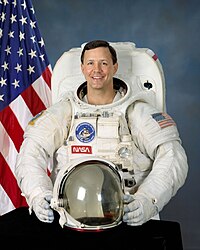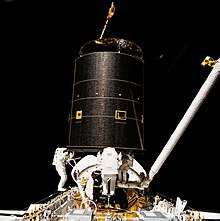Pierre J. Thuot
| Pierre Thuot | |
|---|---|
 | |
| Land | USA |
| Organisation | NASA |
| ausgewählt | 4. Juni 1985 (11. NASA-Gruppe) |
| Einsätze | 3 Raumflüge |
| Start des ersten Raumflugs | 28. Februar 1990 |
| Landung des letzten Raumflugs | 18. März 1994 |
| Zeit im Weltraum | 27d 6h 51min |
| EVA-Einsätze | 3 |
| EVA-Gesamtdauer | 17h 38min |
| ausgeschieden | Juni 1995 |
| Raumflüge | |
Pierre Joseph Thuot (* 19. Mai 1955 in Groton, Bundesstaat Connecticut, USA) ist ein ehemaliger US-amerikanischer Astronaut.
Ausbildung
Thuot erhielt 1977 einen Bachelor in Physik von der United States Naval Academy und 1985 einen Master in Systems Management von der University of Southern California. 2004 erhielt er einen Abschluss vom Harvard Business School Advanced Management Program.
1977 kam Thuot zur United States Navy und wurde zum Marineflieger ausgebildet. Nach Stationierungen auf den Flugzeugträgern USS John F. Kennedy und USS Independence im Mittelmeer und in der Karibik absolvierte er die Navy Fighter Weapons School (TOPGUN) und die U.S. Naval Test Pilot School. Anschließend arbeitete er als Testpilot und Pilotenausbilder.
Astronautentätigkeit
Im Juni 1985 wurde Thuot von der NASA als Astronautenanwärter ausgewählt. Er überprüfte Software im Shuttle Avionics Integration Laboratory und war Verbindungssprecher (CAPCOM) für zahlreiche Shuttle-Missionen. Er war leitender Astronaut des Astronautenbüros für Aufbau- und Wartungsoperationen der Internationalen Raumstation (ISS). Er leitete die Abteilung Mission Support und beaufsichtigte das Astronautentraining der Auswahl von 1995.
STS-36
Thuot startete am 28. Februar 1990 mit der Raumfähre Atlantis zum ersten Mal ins All. Es wurde ein geheimer Satellit der US-Luftwaffe in einen niedrigen Orbit ausgesetzt, von wo aus dieser digitale Aufklärungssatellit den größten Teil der Erdoberfläche überwachen sollte.
STS-49

Am 7. Mai 1992 flog Thuot als Missionsspezialist auf dem Jungfernflug der Raumfähre Endeavour zum zweiten Mal ins All. Ziel dieser Mission war es, den zwei Jahre zuvor gestarteten Kommunikationssatelliten Intelsat VI-F3 für eine Reparatur zu bergen. Erst mit dem dritten Außenbordeinsatz (EVA) konnte der Satellit schließlich von Hand eingefangen werden. Daraufhin erhielt Intelsat einen neuen Apogäumsmotor, damit er eine vorgesehene geostationäre Umlaufbahn erreichen konnte. Bei einer weiteren EVA wurden Strukturen und Werkzeuge getestet.
STS-62
Am 4. März 1994 startete Thuot als Missionsspezialist mit der Raumfähre Columbia zu seinem dritten Weltraumflug. Nutzlast waren die United States Microgravity Payload 2 (USMP) und Office of Aeronautics and Space Technology 2 (OAST). Mit diesen Nutzlasten konnten die Auswirkungen der Schwerelosigkeit erforscht werden.
Nach der NASA
Im Juni 1995 verließ Thuot die NASA und kehrte zur Navy zurück. Später kam er in den Vorsitz der Abteilung für Luft- und Raumfahrttechnik der United States Naval Academy. Im Februar 1999 wurde er Vizepräsident, Administration bei der Orbital Science Corporation, Launch Systems Group. Danach arbeitete er als Senior-Manager für Space & Communications bei Global Aerospace and Defense Industry. Zurzeit ist er Präsident und CEO bei HawkEye.
Privates
Pierre Thuot ist verheiratet und hat zwei Kinder.
Siehe auch
Weblinks
- NASA-Biografie von Pierre J. Thuot (englisch; PDF)
- Biografie von Pierre J. Thuot in der Encyclopedia Astronautica (englisch)
- Kurzbiografie von Pierre J. Thuot bei spacefacts.de
| Personendaten | |
|---|---|
| NAME | Thuot, Pierre J. |
| ALTERNATIVNAMEN | Thuot, Pierre Joseph |
| KURZBESCHREIBUNG | US-amerikanischer Astronaut |
| GEBURTSDATUM | 19. Mai 1955 |
| GEBURTSORT | Groton (Connecticut), Connecticut, USA |
Auf dieser Seite verwendete Medien
STS-49 Patch
- STS-49 Endeavour, Orbiter Vehicle (OV) 105, crew insignia (logo), the official insignia of the NASA STS-49 mission, captures space flight's spirit of exploration which has its origins in the early seagoing vessels that explored the uncharted reaches of Earth and its oceans. The ship depicted on the patch is HMS Endeavour, the sailing vessel which Captain James Cook commanded on his first scientific expedition to the South Pacific. Just as Captain Cook engaged in unprecedented feats of exploration during his voyage, on Endeavour's maiden flight, its crew will expand the horizons of space operations with an unprecedented rendezvous and series of three space walks. During three consecutive days of extravehicular activity (EVA), the crew will conduct one space walk to retrieve, repair and deploy the INTELSAT IV-F3 communications satellite, and two additional EVAs to evaluate the potential Space Station Freedom (SSF) assembly concepts. The flags flying on Endeavour's masts wear the colors of the two schools that won the nationwide contest when Endeavour was chosen as the name of NASA's newest Space Shuttle: Senatobia (Mississippi) Middle School and Tallulah Falls (Georgia) School The names of the STS-49 flight crewmembers are located around the edge of the patch. They are Commander Daniel C. Brandenstein, Pilot Kevin P. Chilton, Mission Specialist (MS) Pierre J. Thuot, MS Kathryn C. Thornton, MS Richard J. Hieb, MS Thomas D. Akers, and MS Bruce E. Melnick. Each crewmember contributed to the design of the insignia.
STS-62 Mission Insignia
Three crewmembers of mission STS-49 hold onto the 4.5 ton International Telecommunications Organization Satellite (INTELSAT) VI after a six-handed "capture" was made minutes earlier during the mission's third extravehicular activity (EVA).
From left to right: Mission Specialists(MS) Richard J. Hieb, Thomas D. Akers, and Pierre J. Thuot.
The three prepare to attach the capture bar which is tethered to Hieb. Thuot is positioned on the Remote Manipulator System (RMS) arm, from which he had made two earlier unsuccessful grapple attempts on two-person EVA sessions. Ground controllers and crewmembers agreed that a third attempt, using three mission specialists in the payload bay (PLB) was the effort needed to accomplish the capture feat. It worked, and to date, this remains the only three-person EVA.
Behind the three astronauts is the vertical perigee stage which will be attached to the Intelsat VI prior to its release from the PLB.Portrait des Astronauten Pierre Thuot
STS-36 Mission Insignia




